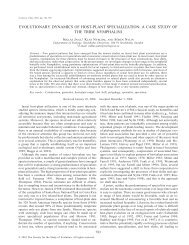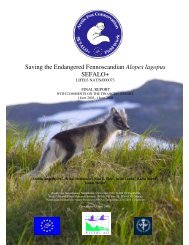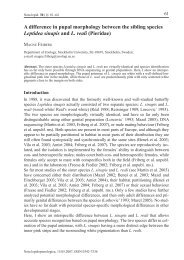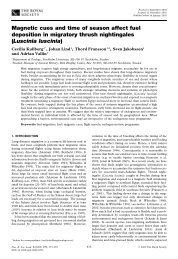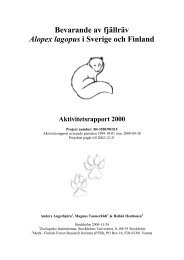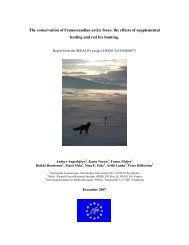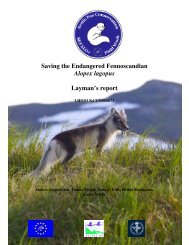Evolution of Fighting Behaviour: The Effect of Variation in Resource ...
Evolution of Fighting Behaviour: The Effect of Variation in Resource ...
Evolution of Fighting Behaviour: The Effect of Variation in Resource ...
You also want an ePaper? Increase the reach of your titles
YUMPU automatically turns print PDFs into web optimized ePapers that Google loves.
190 M. ENQUIST AND O. LEIMARfight<strong>in</strong>g ability is obta<strong>in</strong>ed by the contestants dur<strong>in</strong>g a fight. If the value <strong>of</strong> theresource is higher for one role (the favoured role), the common sense ESS for thisgame has the property that an <strong>in</strong>dividual <strong>in</strong> the favoured role will be more persistent<strong>in</strong> fight<strong>in</strong>g than an <strong>in</strong>dividual <strong>in</strong> the other role, so that the favoured role will w<strong>in</strong>most fights. If the disparity <strong>in</strong> resource value between the roles is not too great, thegame also has a paradoxical ESS where the favoured role is less persistent; however,such an ESS has a small bas<strong>in</strong> <strong>of</strong> attraction. An <strong>in</strong>crease <strong>of</strong> the resource value foreither role has the effect, both for the common sense and the paradoxical ESS, thatthat role w<strong>in</strong>s more fights.An <strong>in</strong>dividual's subjective resource value might not be completely specified bythe role. An <strong>in</strong>terest<strong>in</strong>g situation <strong>of</strong> this k<strong>in</strong>d is an <strong>in</strong>formation asymmetry, i.e. whenthe <strong>in</strong>dividual <strong>in</strong> one role has more <strong>in</strong>formation. This could be the case <strong>in</strong> manyowner-<strong>in</strong>truder <strong>in</strong>teractions, s<strong>in</strong>ce the owner may be better <strong>in</strong>formed about theresource than the <strong>in</strong>truder (Sigurj6nsd6ttir & Parker, 1981).General PropertiesA common, although not universal, f<strong>in</strong>d<strong>in</strong>g for games with variation <strong>in</strong> resourcevalue is that an ESS will prescribe more costly strategies when resource value<strong>in</strong>creases. <strong>The</strong> <strong>in</strong>creased cost may result from <strong>in</strong>creased persistence <strong>of</strong> the animaland/or from the use <strong>of</strong> more costly behaviour patterns. For <strong>in</strong>stance, <strong>in</strong> the Hawk-Dove game (Maynard Smith & Parker, 1976) where the ESS is to play Hawk withprobability q and Dove with probability 1-q (the Hawk strategy is more costlythan the Dove strategy), <strong>in</strong>creas<strong>in</strong>g the resource value will change the ESS so thatq <strong>in</strong>creases until q = 1. On the other hand, if there is a role asymmetry with resourcevalue be<strong>in</strong>g determ<strong>in</strong>ed by the role and if the subjective resource value to one roleis <strong>in</strong>creased, an ESS may change <strong>in</strong> such a way that the cost <strong>of</strong> an <strong>in</strong>teractiondecreases (Leimar & Enquist, 1984). <strong>The</strong> reason for this is that, although the favoredrole <strong>in</strong>creases <strong>in</strong> persistence, the other role may become cautious and even decl<strong>in</strong>eto fight.In order to clarify to what extent the effects <strong>of</strong> variation <strong>in</strong> resource value thatare suggested by theoretical models and empirical results are general consequences<strong>of</strong> evolutionary game theory, we will consider three different (and somewhat idealized)<strong>in</strong>formational situations. First, <strong>in</strong> a symmetric situation where resource valueis the same for both contestants, each resource value results <strong>in</strong> an <strong>in</strong>dependentgame. Let S(V) be an ESS for the game when resource value is V and assume thatS(V) varies gradually with E One would expect that the cost <strong>of</strong> a contest whereS(V) meets itself should <strong>in</strong>crease with V. However, from game theory alone it isnot possible to derive such a result. What can be shown is that if S(V) has theadditional property <strong>of</strong> cont<strong>in</strong>uous stability, it will become more "dar<strong>in</strong>g" as V<strong>in</strong>creases (the concept <strong>of</strong> a cont<strong>in</strong>uously stable strategy was <strong>in</strong>troduced by Eshel(1983) and entails that if a population uses a strategy that is close to the ESS, thenevolution tends to move the population closer to the ESS). Namely, <strong>in</strong> a contestbetween S(V1) and S(V2) with VI slightly greater than V2, S(Vt) will w<strong>in</strong> morethan half the fights and take a higher cost than S(V2) aga<strong>in</strong>st itself, i.e. S(Vt) ismore effective and more costly than S(V2) <strong>in</strong> contests aga<strong>in</strong>st S(V2). See Appendix



